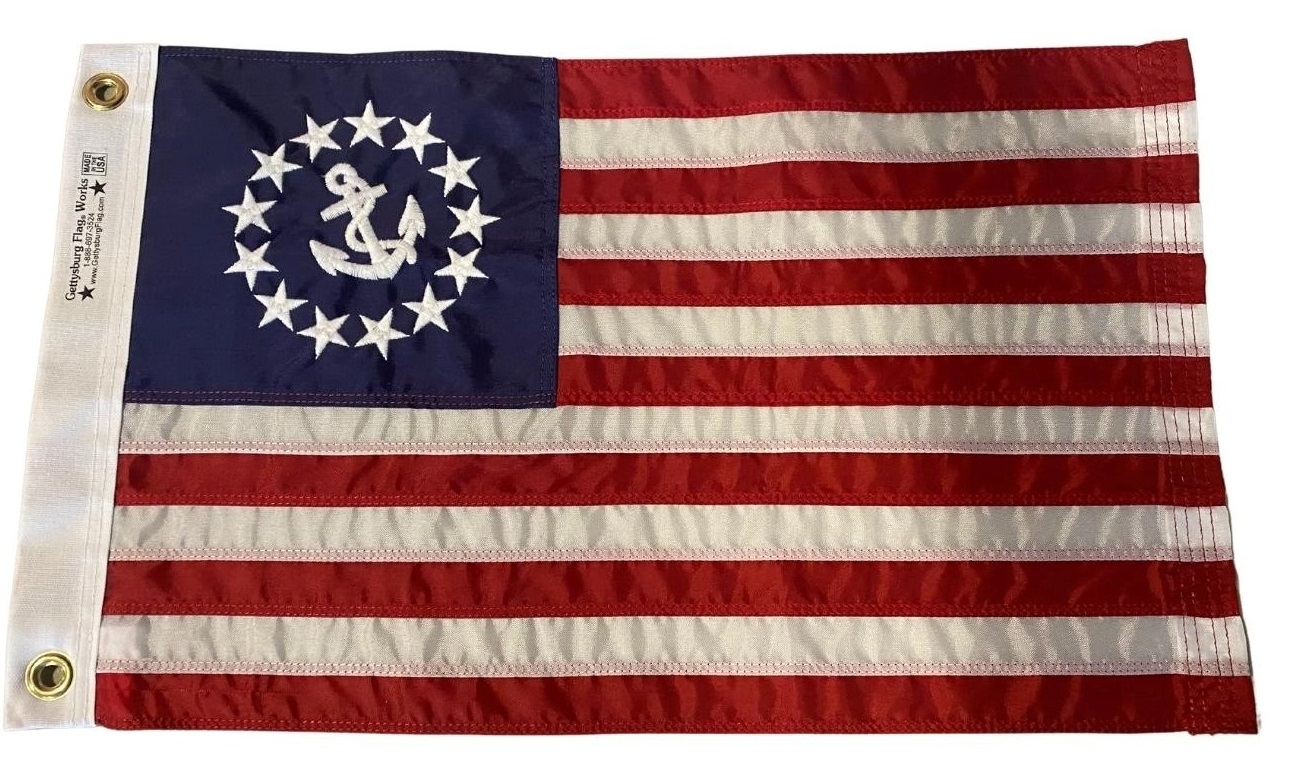About the U.S. Yacht Ensign
 International maritime law requires that vessels have a “national character” and that they display a flag, or ensign, that corresponds to this character, especially when in international or foreign waters. A yacht ensign is simply the national flag flown on ships and large boats to denote nationality. It is the largest flag on board, and it is typically flown at the stern, or rear, of the ship.
International maritime law requires that vessels have a “national character” and that they display a flag, or ensign, that corresponds to this character, especially when in international or foreign waters. A yacht ensign is simply the national flag flown on ships and large boats to denote nationality. It is the largest flag on board, and it is typically flown at the stern, or rear, of the ship.
While the International maritime law primarily applies to vessels owned by the U.S. government and military, small, non-registered craft owned by U.S. citizens may also hoist a U.S. ensign to show their national character. The United States ensign is the American Flag, however, many privately-owned recreational craft use the U.S. Yacht Ensign in place of the national flag.
U.S. Yacht Ensign Design
The U.S. Yacht Ensign is a modified version of the American flag. It has the same 13 red and white stripes, as well as navy blue canton in the upper left corner. However, inside the canton, the 50 white stars are replaced with a fouled anchor in a circle of thirteen stars. Most yacht ensigns are manufactured in 2:3 or 3:5 proportions, but the traditional dimensions are the same as the national ensign, 10:19.
History of the U.S. Yacht Ensign
The U.S. Yacht Ensign was created by an Act of Congress in August 1848. However, the legislation did not authorize the U.S. Yacht Ensign to replace the national flag as a means of identifying the vessel’s nationality. In fact, the secretary of the New York Yacht Club specifically described the flag as a “distinguishing flag to be worn at the masthead,” and not as an ensign that would have been flown at the stern or gaff.
The intention of the law, and the purpose of the U.S. Yacht Ensign, was to indicate that a yacht was licensed by the Treasury Department, allowing private boats meant for pleasure, cruising and racing to move between ports without the need to clear customs. Yachts eligible for the license were initially 20 net tons and over, later reduced to 15 net tons, because smaller craft were not subject to the same customs rules.
The Navy fervently argued that the U.S. Yacht Ensign was meant to be used in addition to the national ensign, not in place of it. Yet, most yachtsman continued to use it in lieu of the national flag, and boats of all sizes, regardless of whether or not they held the Treasury Department license, began flying the U.S. Yacht Ensign from their sterns.
U.S. Yacht Ensign Accepted as National Ensign
The Navy eventually recognized the U.S. Yacht Ensign as a substitute for the national ensign in 1939, and the argument over which boats were eligible to fly the flag became a moot point in 1980 when the Vessel Documentation Act removed the special yacht license, along with the requirement to display the yacht flag.
Today, the United States Power Squadrons’ guide to flag etiquette provides that the U.S. Yacht Ensign may be flown as an alternative to the national ensign by U.S. recreational boats of all types and sizes. However, the standard national ensign should still be used when in international or foreign waters.
Honoring Tradition with the U.S. Yacht Ensign
Continuing a tradition that dates back to the mid-nineteenth century, the yacht ensign is now flown as a matter of custom by many recreational boats and yachts, including American journalist, author, television writer and yachtsman, Christian Williams.
Williams recently featured our U.S. Yacht Ensign in his YouTube Video, “Why We Sail — Refit and Hey, Why no Dodger?” The flag in the below video clip logged 15,000 nautical miles, and, as Williams notes, “It’s in better condition than he was.”

How could Williams sail 15000 miles with a yacht ensign in contravention of the rule that restricts the yacht ensign validity to US waters only?
luxury yacht is really amazing activity to do. I also want to use this luxury yacht service